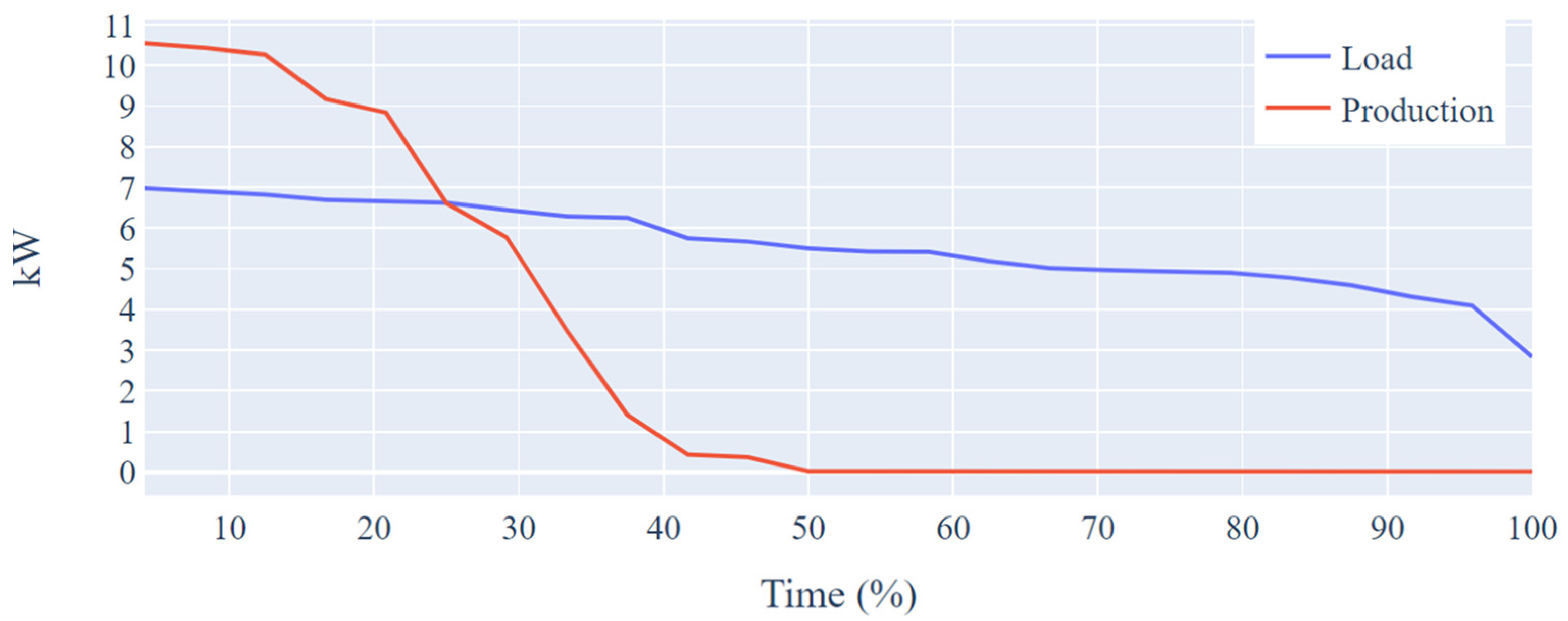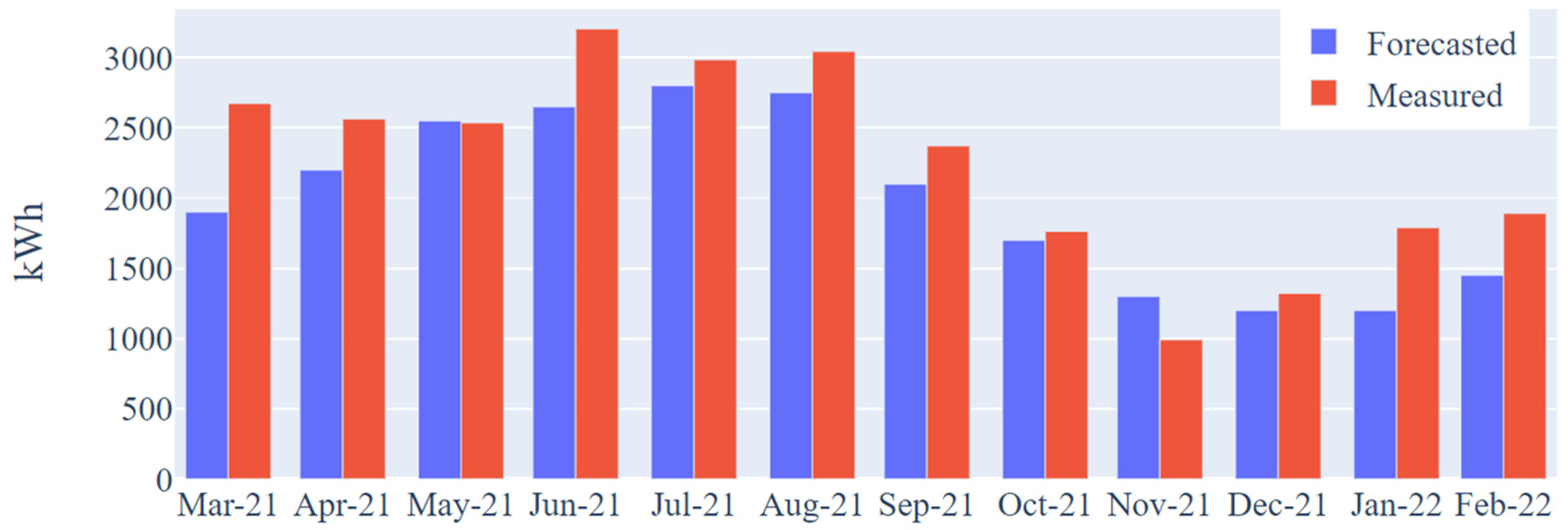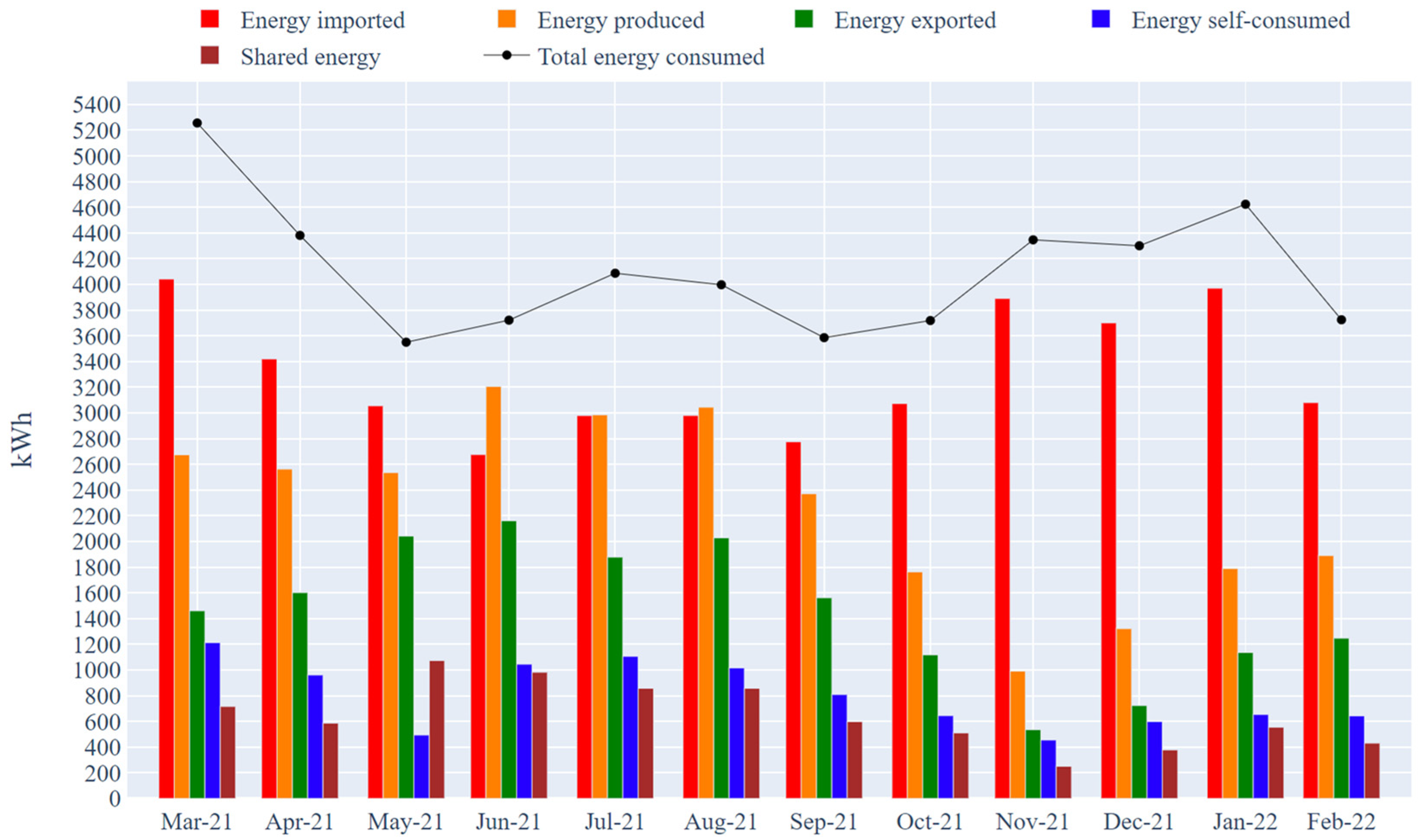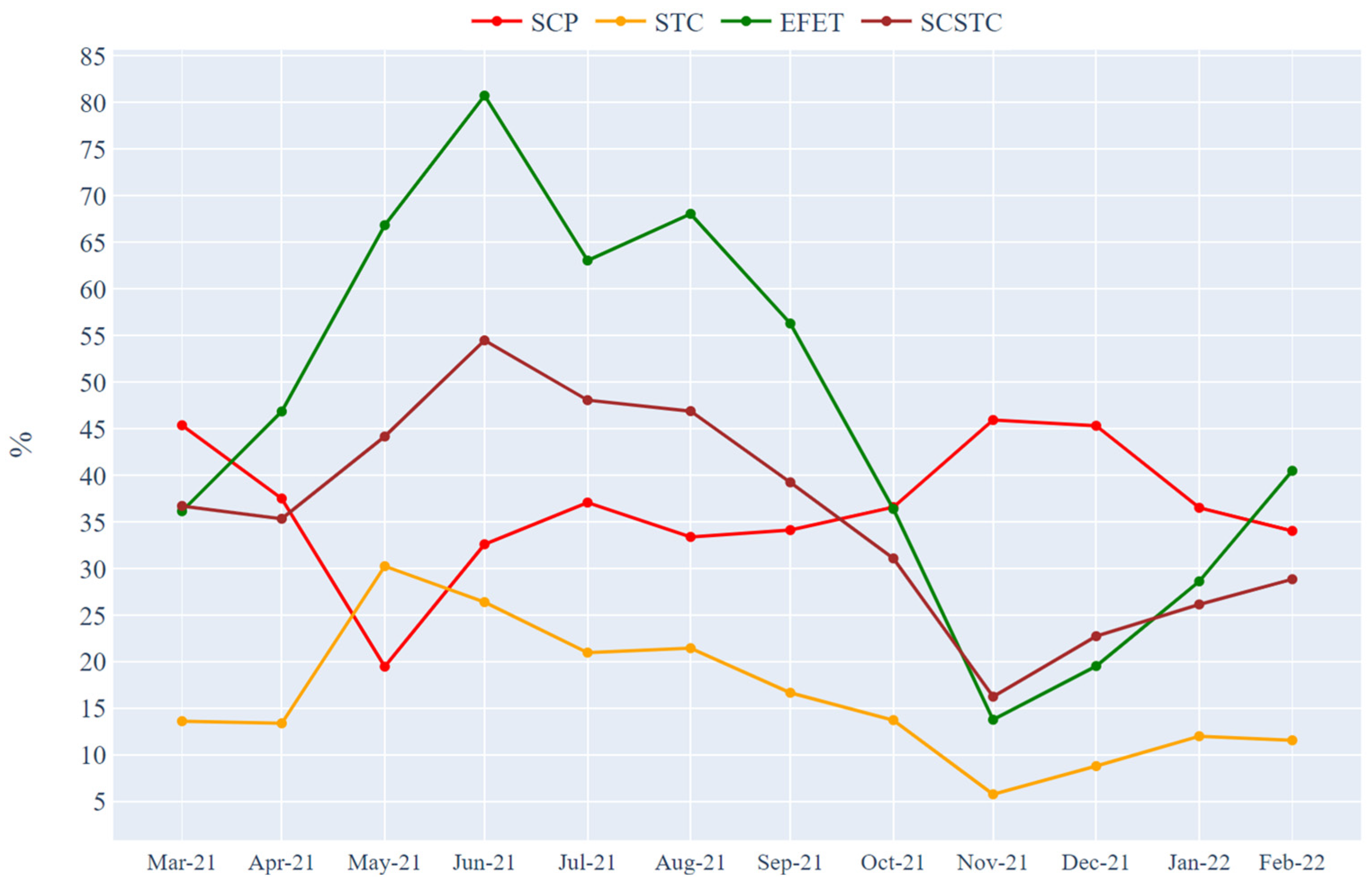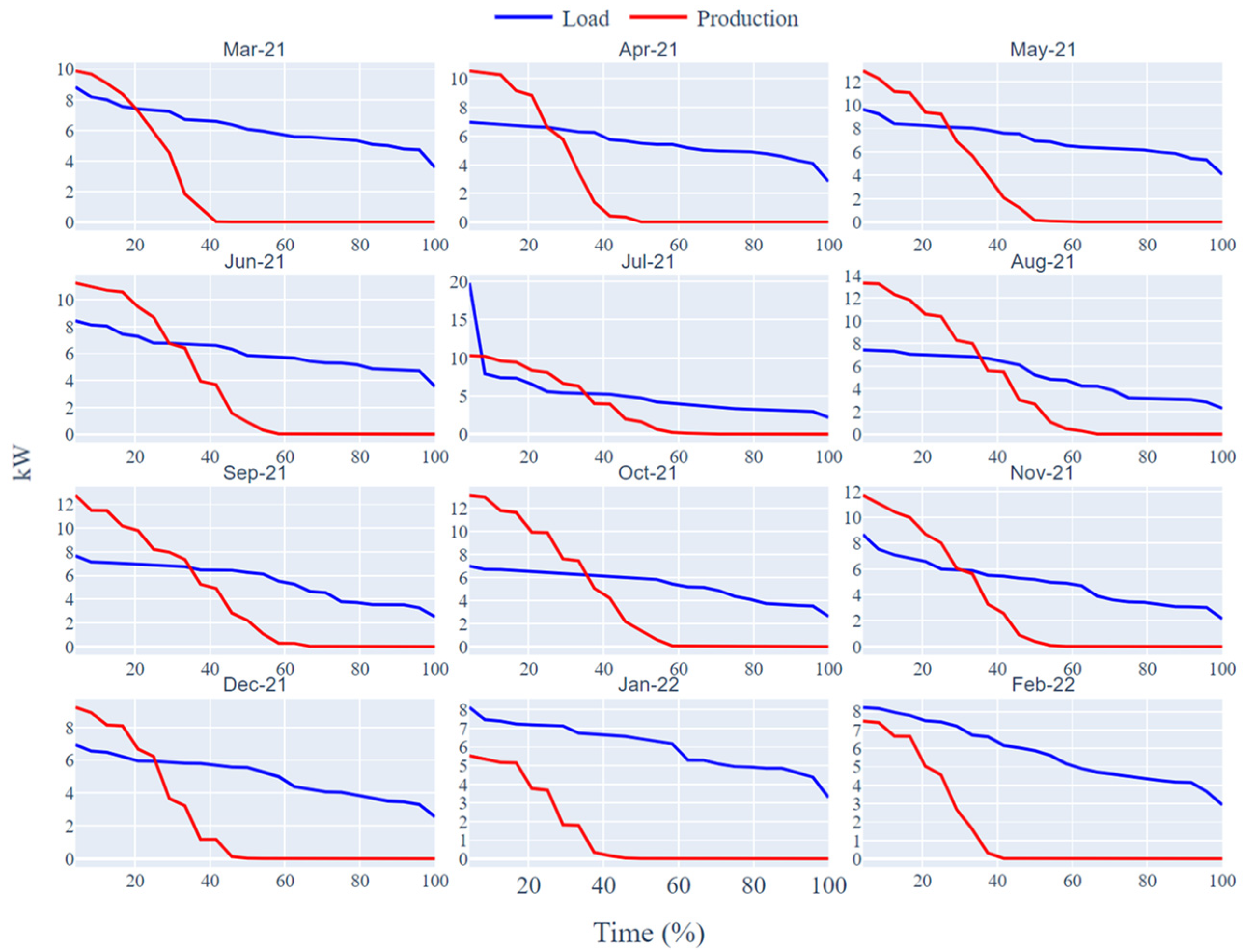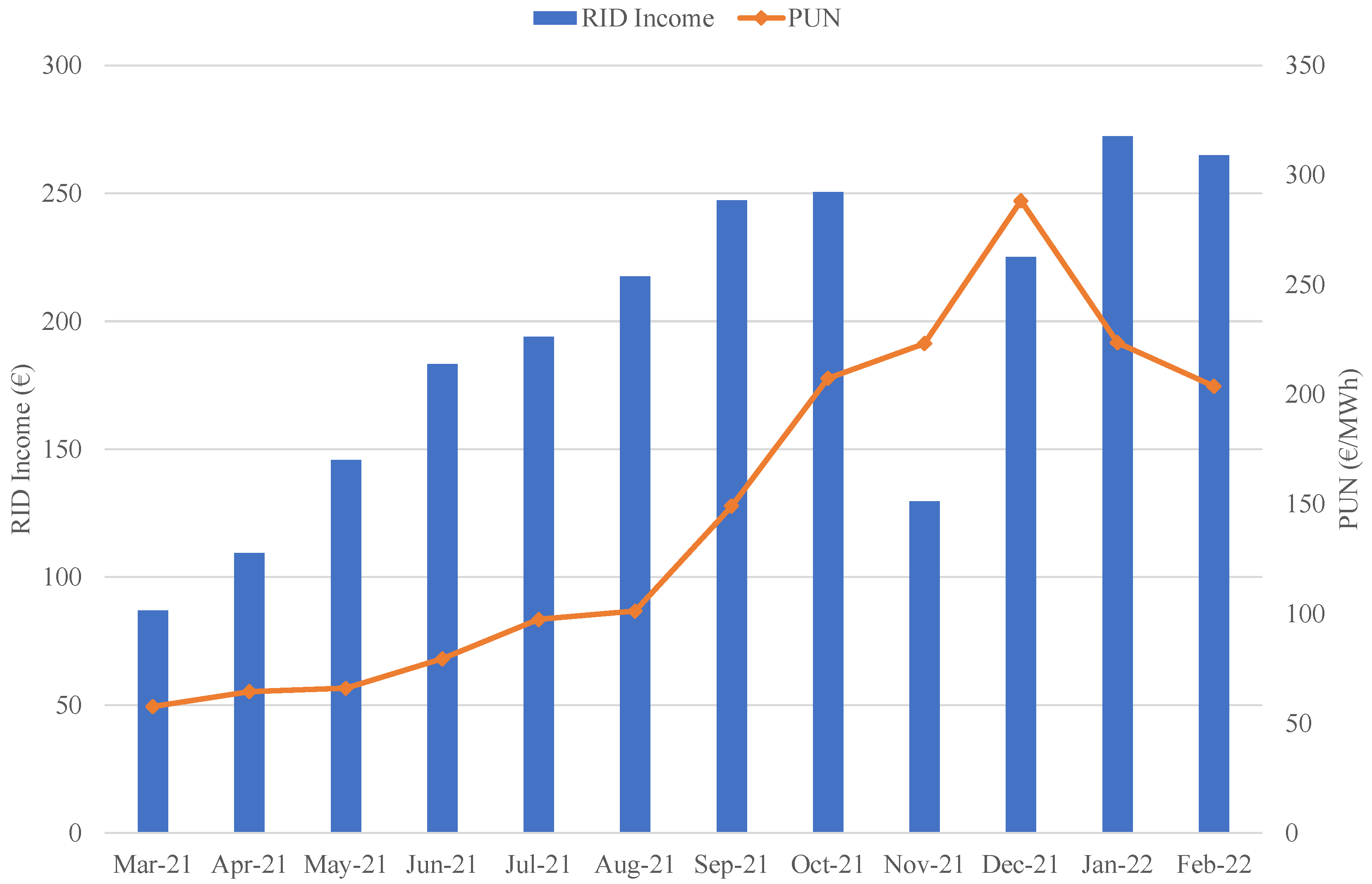In this section, an overview of the main features of the Magliano Alpi energy community is presented. Then, the quantities of interest and the metrics employed in the following sections of the article to assess the community’s performance will be presented and analyzed.
2.1. Magliano Alpi REC General Characteristics
Figure 1 presents an aerial view of the REC of Magliano Alpi where the distribution network, the MV/LV substation, and the location of the participants are highlighted.
Figure 2 shows a simplified scheme of the distribution network and the users of the REC.
The energy community manages a photovoltaic system whose energy is shared with some municipal buildings, a small manufacturing company, and three families that joined the REC under the call of the municipality. The PV system is installed on the rooftop of the town hall. The energy production is used to power the load of the building, as well as an electric vehicle (EV) charging plug, which can be used by the citizens free of charge. The PV plant is composed of 60 modules of 330 kWp each for a nominal power of 19.80 kWp. The total annual energy output was estimated at 24,198 kWh/year.
Table 1 summarizes the annual energy consumption and the bill paid by the members of the community.
The data on which this analysis is based were recorded with smart meters (SM) installed at end users’ premises. SMs are crucial in the implementation of a REC as they allow one to increase the knowledge of energy usage and production for the purpose of energy and market management [
34]. Smart metering systems allow the implementation of effective demand response and flexibility, enabling an interaction among the user, third parties (e.g., aggregators), and network and market operators [
35,
36,
37]. The SMs are used to continuously save bidirectional information on active and reactive power and phase angle measurements, both in single and three-phase modes. The measurements were performed according to the European MID directive [
38]. Data are accessible via a software platform that allows the exchange of information with internet of things (IoT) appliances and the energy management system.
Data were provided in an excel file and analyzed using Python programming language using the Pandas and Scipy libraries. The SMs registered the initial raw data, which consist of measurements of active energy fed to and withdrawn from the grid detailed per POD code, but also in an aggregated form already summarized for the community. A dedicated meter was installed to measure the PV production. Data registered from the individual SMs went through a control and cleaning procedure. Then, data relative to the measurements of the single SM were aggregated to obtain information at a community level. Said information was then compared to those registered to verify for any discrepancies. The consistency between measured and stored information was the object of assessment. Power consumption and production data were stored hourly as a cumulative quantity. To perform evaluations on different periods. it was necessary to proceed to the calculation of differential quantities. It was then possible thanks to the fact that an SM was installed in correspondence with the PV plant to compute the self-consumption of the REC members. In the case under analysis, only the municipality building can self-consume the energy produced since the only production plant is located on its roof.
2.2. Performance Metrics Used to Evaluate the Energy Community
One of the objectives of the present paper was to provide a focus on a broader perspective, suitable for an evaluation of the Magliano Alpi REC, that can be generalized for other energy communities with similar characteristics that have been implemented according to Italian regulations. For this reason, the authors defined and used some key performance indexes in this study that can be generalized and used to analyze and compare the energetic and economic performance of any energy community. To analyze the energetic performance of the REC, the parameters are defined and calculated in
Table 2 for the REC.
In the case under analysis, the connection points were the REC’s users and the metrics were calculated according to the technical rules [
39] provided by the GSE (“Gestore dei Servizi Energetici”—Energy Services Manager).
Figure 3 presents an explanatory graph of the REC’s energy flows in which the parameters of interest presented in
Table 2 are reported. The graph also displays the constituents of the REC itself in terms of facilities and members in proximity to the quantities to which they contribute.
Let
CP b the number of connection points in the REC (i.e., the number of members). It is possible to define
TCh, the total consumed energy for the
h-th hour, as the sum of the energy withdrawn from the grid and the self-consumed energy over the same period:
The total energy consumed by a single user,
TCy,h can then be calculated by fixing the
y-th index. The energy self-consumed by the
y-th connection point (i.e., a user in the community) on the
h-th hour can be expressed as the difference between the energy produced and the energy it injects into the grid.
The total energy self-consumed by the community, over the
h-th hour, can then be calculated as:
The energy exported to the grid by the community, relevant to our studies, during the hour
h can be expressed as the sum of the energy exported by every
y-th connection point:
The energy withdrawn from the grid during the hour
h is the sum of the energy withdrawn from each connection point in the configuration:
Thus, the shared energy at the
h-th hour is calculated as:
The first argument of the min function in Equation (6) is the total energy injected into the grid by the REC, whilst the second term is the energy withdrawn from the grid. Hence, for example, the shared energy for month “
M” can be calculated by computing the shared energy of every single hour for every single day of the month as in (5):
where
DM is the number of days in the
M-th month.
It is essential to understand that the designed metrics can be obtained for different time frames and, within this scope, have been computed mostly over a monthly interval. In the following, SEj will be used to indicate the shared energy for the general period, depending on the granularity of the conducted analysis. It is important to point out that in the above equations, the value for the shared energy (SEj) at the j-th period is computed by aggregating the values calculated with definition (6).
In general, the locally produced energy is self-consumed by the city hall, and the production excess is fed into the grid. The community meets its electrical demand by withdrawing electricity from the grid. This can either be produced locally or produced and fed into the grid by third parties. The law for determining the amount of shared energy is formulated in Equation (6). The total energy consumption of the community is calculated as the sum of the self-consumption and the withdrawals from the grid. The energy that is withdrawn from the grid can be referred to as either shared energy or non-shared energy, depending on the governing law. The energy injected into the grid that is not counted in the shared energy is effectively an excess of production and can be considered a loss of local value since it is not consumed locally. To maximize the local retention of value, i.e., the energy produced by the REC’s facility, it is necessary to maximize the shared energy. This goal, as is well known, can be achieved by synchronizing production and consumption, but also by introducing storage systems that allow the consumption of locally produced green energy to be deferred. However, in the case under consideration during the financial planning and design phase and of the community, storage systems were not considered. Such systems would undoubtedly allow for a substantial increase in the community’s energy performance, but not necessarily in the economic performance given the high investment costs.
Table 3 briefly summarizes the KPIs that have been developed and employed to conduct the analysis of the REC.
A more thorough description of the equations employed to compute the parameters used in the study is reported in the following:
SCP is defined as the total energy self-consumed over the total energy produced by the PV plant for the general
j-th period in analysis. This metric is informative about the ability of instant physical self-consumption of the energy produced by the PV plant.
where
N is the number of periods over which the parameter is computed,
SCj (kWh) is the self-consumed energy over the
j-th period, and
TPj (kWh) is the total energy produced over the
j-th period.
STC is defined as the shared energy over the total energy consumed by the community. The parameter thus defined provides information about the ability of the community to meet its energy needs through locally produced energy.
where
SEj is the total energy shared over the
j-th period and
TCj is the total energy consumed over the same period.
EFET is defined as the energy fed to the grid over the energy withdrawn from the grid. If greater than 100, the energy fed to the grid exceeds that withdrawn. This parameter provides a general idea of whether the PV plant for the community is balanced.
where
EFGj (kWh) and
ETGj (kWh) are, respectively, the energy fed and withdrawn to and from the grid over the
j-th period.
SCSTC is defined as the ratio of the sum of the total self-consumed energy and the shared energy over the total energy needs.
SCSTC has been designed with the aim to evaluate the ability of the community to satisfy its energy demand with valorized and incentivized energy. Self-consumption can be considered an avoided expense whilst the shared energy is incentivized by the State. Hence, the KPI relates quantities that can provide economic benefits to the community in relation to its total consumption. On the other hand, if the interest is to evaluate the sustainability of the REC, it is possible to achieve such a result by jointly considering the EFET and SCSTC KPIs to understand whether the community is taking advantage of the economic incentives in relation to the energy locally produced. Ideally, the maximum incentive for shared energy is received when the energy (on an hourly basis) supplied by the grid equals the energy injected. The EFET determines the maximum theoretical achievable percentage for the period. If EFET is equivalent to 100 for each month, the REC would (theoretically) be able to balance its grid withdrawals with its inputs while maximizing the perceived sharing incentive. The SCSTC parameter, on the other hand, considers both physically self-consumed energy and energy valid for the sharing incentive to relate them to the energy needs. Moreover, in this case, a value as high as possible is preferred as it means a greater saving for the community and, at the same time, the ability to maximize the shared energy.
The following analysis was performed considering data aggregated over a year and over a month: These time frames have been preferred to others (weekly, hourly, and daily) for the impact capabilities of providing significant information to interpret the REC performance. Hourly data have been used to compute the shared energy by the community as specified in the technical regulations provided by the GSE and to realize a load shifting simulation. which will be presented in the following sections of the manuscript. The results obtained from the performed analysis are presented in the following section.



